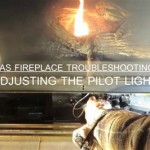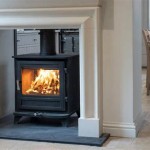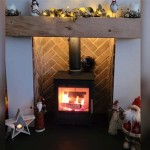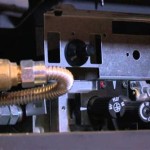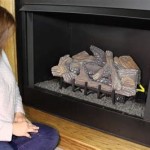Understanding and Choosing a Fake White Fireplace
The concept of a fake white fireplace encompasses a range of artificial fireplace options designed to emulate the aesthetic appeal of a traditional white fireplace without the operational requirements or inherent risks associated with real wood-burning or gas-fueled fireplaces. These alternatives leverage various technologies and design approaches to achieve a visually convincing and often functional addition to a home or commercial space.
The popularity of fake white fireplaces stems from several factors. Firstly, they offer a safer alternative to traditional fireplaces, eliminating the risk of sparks, smoke inhalation, and carbon monoxide poisoning. Secondly, they bypass the need for chimney maintenance, wood storage, or gas line installations, resulting in cost savings and convenience. Thirdly, they provide a clean and modern aesthetic, seamlessly integrating into various interior design styles, particularly those favoring minimalist or contemporary themes. Finally, they can be installed in locations where traditional fireplaces are not feasible or permitted due to structural or regulatory constraints.
Key Aspects of Fake White Fireplace Options
Fake white fireplaces encompass diverse technologies and styles, each with distinct characteristics and applications. Understanding these options is crucial for making informed decisions aligned with individual needs and preferences. Three primary categories include electric fireplaces, gel fireplaces, and faux fireplace surrounds.
Electric Fireplaces: Electric fireplaces utilize electric heating elements to generate warmth and project simulated flames onto a screen or display. These models come in various forms, including freestanding units, wall-mounted units, and inserts designed to fit into existing fireplace openings. The realism of the flame effect varies significantly depending on the technology used. Some models employ simple rotating reflectors and colored lights, while others utilize advanced LED technology and holographic projections to create more convincing and dynamic flame simulations. Electric fireplaces offer adjustable heat settings, allowing users to control the level of warmth emitted. Features such as timers, remote controls, and built-in thermostats enhance user convenience. The energy efficiency of electric fireplaces varies depending on the model and usage patterns. While they consume electricity, they can be more energy-efficient than traditional space heaters, especially when used to zone-heat a specific area. Furthermore, electric fireplaces require no venting, making them easy to install in virtually any room.
Gel Fireplaces: Gel fireplaces, also known as ethanol fireplaces, use a specially formulated gel fuel to produce real flames. The gel fuel is typically alcohol-based and burns cleanly, producing minimal smoke or soot. Gel fireplaces offer a more authentic flame experience compared to electric fireplaces, as the flames are generated by combustion rather than simulation. However, gel fireplaces produce significantly less heat than traditional fireplaces or electric fireplaces. They are primarily used for their aesthetic appeal rather than their heating capabilities. Gel fireplaces require proper ventilation, although not as extensive as that required for wood-burning fireplaces. It is essential to ensure adequate airflow in the room to prevent the build-up of carbon dioxide. The gel fuel cartridges are relatively expensive compared to the cost of electricity or wood, adding to the operating expenses of a gel fireplace. The design options for gel fireplaces are less diverse compared to electric fireplaces. They typically feature a simple metal or stone frame with openings for the gel fuel cartridges to burn. Safety is paramount when using gel fireplaces. The flames are real, and the surfaces of the fireplace can become hot. It is essential to follow the manufacturer's instructions carefully and keep flammable materials away from the fireplace. Refueling the gel cartridges should only be done when the fireplace is completely cool.
Faux Fireplace Surrounds: Faux fireplace surrounds are decorative structures designed to mimic the appearance of a traditional fireplace without any actual fire or heating functionality. These surrounds are typically made of wood, MDF, or synthetic materials and are available in various styles, from classic and ornate to modern and minimalist. Faux fireplace surrounds can be used to create a focal point in a room, adding architectural interest and visual appeal. They can be paired with candles, decorative logs, or electric fireplace inserts to further enhance the ambiance. The primary advantage of faux fireplace surrounds is their versatility. They can be easily customized to match existing décor and can be installed in virtually any location. They require minimal maintenance and pose no safety risks, making them an ideal option for households with children or pets. The cost of faux fireplace surrounds varies depending on the materials used, the complexity of the design, and the size of the surround. Pre-fabricated surrounds are generally more affordable than custom-built surrounds. The installation process for faux fireplace surrounds is relatively straightforward. They can be attached to the wall using screws or adhesive, depending on the weight and design of the surround. The addition of decorative elements, such as mantels, shelves, and trim, can further enhance the realism and visual appeal of the faux fireplace surround.
Selecting the Right Fake White Fireplace for Specific Needs
The selection of an appropriate fake white fireplace necessitates a careful evaluation of individual requirements and preferences. Factors such as room size, heating needs, desired aesthetic, budget, and safety considerations play a crucial role in the decision-making process. A strategic approach involves defining the primary purpose of the fireplace and aligning the chosen option with the intended application.
Assessing Room Size and Heating Needs: The size of the room where the fireplace will be installed is a critical factor. For smaller rooms, a smaller electric fireplace or a gel fireplace may be sufficient to provide a subtle ambiance. Larger rooms may require a more powerful electric fireplace with a higher BTU (British Thermal Unit) rating to effectively heat the space. It is important to consider the insulation and climate of the region when determining the heating needs of the room. Poorly insulated rooms will require more heating power compared to well-insulated rooms. If the primary goal is aesthetic enhancement rather than heating, a faux fireplace surround or a low-heat gel fireplace may be a suitable option. Electric fireplaces offer adjustable heat settings, allowing users to customize the level of warmth to suit their comfort preferences. The versatility of electric fireplaces makes them a suitable option for rooms of varying sizes and heating requirements.
Aligning Aesthetic Preferences with Design Options: Fake white fireplaces are available in a wide range of styles, from traditional and ornate to modern and minimalist. The chosen style should complement the existing décor and architectural features of the room. For classic interiors, a faux fireplace surround with traditional detailing, such as fluted columns and decorative moldings, may be an appropriate choice. Contemporary interiors may benefit from a sleek and minimalist electric fireplace with a clean white finish. The color and texture of the surrounding walls and furniture should be considered when selecting the style of the fake white fireplace. The goal is to create a cohesive and visually appealing focal point that enhances the overall aesthetic of the room. Online resources and interior design magazines can provide inspiration and guidance in selecting the right style of fake white fireplace for specific design preferences. The ability to customize faux fireplace surrounds allows users to create a unique design that reflects their personal style and preferences.
Budget Considerations and Long-Term Costs: The initial cost of a fake white fireplace can vary significantly depending on the type, size, features, and materials used. Electric fireplaces generally range from a few hundred dollars to several thousand dollars, depending on the complexity of the flame simulation and the heating capacity. Gel fireplaces are typically less expensive than electric fireplaces, but the ongoing cost of gel fuel can add up over time. Faux fireplace surrounds range in price depending on the materials used and the complexity of the design. In addition to the initial cost, it is essential to consider the long-term operating costs. Electric fireplaces consume electricity, and the cost of electricity will vary depending on usage patterns and local electricity rates. Gel fireplaces require the purchase of gel fuel cartridges, which can be relatively expensive. Faux fireplace surrounds have minimal operating costs, as they do not require any fuel or electricity. A careful analysis of the initial cost and long-term operating costs is crucial for making a financially sound decision. Consider the lifespan of the fireplace and the potential for repairs or replacements when evaluating the overall cost-effectiveness of different options.
Installation and Maintenance of Fake White Fireplaces
Proper installation and maintenance are essential for ensuring the safe and efficient operation of fake white fireplaces. The specific installation procedures and maintenance requirements will vary depending on the type of fireplace and the manufacturer's instructions. Adhering to these guidelines is crucial for maximizing the lifespan of the fireplace and preventing potential hazards.
Electric Fireplace Installation and Safety: Electric fireplaces typically require minimal installation. Freestanding units simply need to be plugged into a standard electrical outlet. Wall-mounted units require some basic assembly and mounting hardware. It is essential to follow the manufacturer's instructions carefully to ensure proper installation and prevent damage to the unit or the wall. Electric fireplaces should be plugged into a grounded outlet and should not be used with extension cords. If the electric fireplace has a heating function, it should be kept away from flammable materials, such as curtains, furniture, and bedding. Regular cleaning of the electric fireplace is important for maintaining its performance and appearance. The exterior can be cleaned with a damp cloth, and the heating element should be vacuumed periodically to remove dust and debris. Avoid using abrasive cleaners or solvents, as they can damage the surface of the fireplace. Inspect the power cord regularly for signs of damage, and replace it if necessary. Never attempt to repair an electric fireplace yourself. Contact a qualified electrician for any repairs or maintenance.
Gel Fireplace Safety and Maintenance: Gel fireplaces require careful handling due to the use of real flames. Always follow the manufacturer's instructions for fueling and operating the fireplace. Use only approved gel fuel cartridges and never attempt to refill empty cartridges. Ensure adequate ventilation in the room to prevent the build-up of carbon dioxide. Keep flammable materials away from the fireplace and supervise children and pets when the fireplace is in use. Never leave a burning gel fireplace unattended. The surfaces of the fireplace can become hot, so avoid touching them while the fireplace is in operation. Allow the fireplace to cool completely before refueling or cleaning. Clean the fireplace regularly with a damp cloth to remove any spills or residue. Dispose of empty gel fuel cartridges properly according to local regulations. Store gel fuel cartridges in a cool, dry place away from heat and flame. The safety of gel fireplaces is paramount, and adherence to these guidelines is crucial for preventing accidents and injuries.
Faux Fireplace Surround Installation and Care: Faux fireplace surrounds typically require some assembly and mounting. Follow the manufacturer's instructions carefully to ensure proper installation. Use appropriate hardware and fasteners to securely attach the surround to the wall. The weight of the surround will determine the type of fasteners required. Regularly dust the surround with a soft cloth to remove any dirt or debris. Avoid using abrasive cleaners or solvents, as they can damage the surface. If the surround is made of wood, apply a wood polish or protectant to maintain its finish and prevent it from drying out. Inspect the surround regularly for signs of damage, such as cracks or chips. Repair any damage promptly to prevent it from worsening. The maintenance of faux fireplace surrounds is relatively simple, but regular care is essential for preserving their appearance and structural integrity. The installation process for faux fireplace surrounds is relatively straightforward, but it is important to take precautions to prevent injuries. Use safety glasses and gloves when assembling and mounting the surround. Consult with a professional if you are unsure about any aspect of the installation process.

20 Fake Fireplace Ideas Universe Faux Diy Mantle Decor

How To Use Faux Fireplace In Home Decor Idee Camino Case Vittoriane Abitazioni Shabby Chic

Faux Marble Fireplace Savvy Apron

If You Re Going To Make It Better Fake Diy Brick Fireplace

Diy Faux Fireplace For Under 600 The Big Reveal Bless Er House

Faux Fireplace A Great Idea Or Disaster Laurel Home

Birch Log Bundles Just For Show Faux Fireplace Home Decor

How I Built A Faux Modern Farmhouse Fireplace Anderson Grant

12 Gorgeous Diy Faux Fireplace Ideas The Turquoise Home

How To Build A Faux Fireplace Engineer Your Space
Related Posts



